
Nebraska County Fossils
Lancaster
< Vertebrate Paleontology Home
A virtual journey through the Museum's vertebrate paleontology collection.
Equus, Ice Age Horse
Family: Equidae
Geologic age: Pleistocene (Rancholabrean), about 20,000 years old
Year fossil collected: 1965
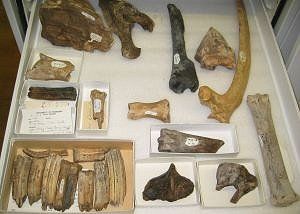

Horses originated in North America, but became extinct here about 10,000 years ago. Equus, the modern genus of horse, was widespread in Nebraska during the Pleistocene, and its fossil remains can be found in many of the creeks and streams that flow through Lancaster County. All horses in North America today are descendants of horses reintroduced here from Europe in historic times.
Mammuthus columbi, Columbian mammoth
Family: Elephantidae
Geologic age: Pleistocene, about 25,000 years old
Year fossil collected: 1951

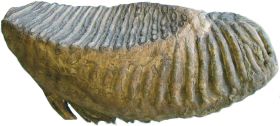
Long before the city of Lincoln was dreamed of, before humans had even set foot here, mammoths roamed the plains in Lancaster County. Their teeth, the most durable part of their skeletons, are preserved in the Pleistocene sediments that cover the county. They are often found in stream beds, gravel pits, and even farm fields throughout Nebraska. If mammoths had survived until today, and still lived in Nebraska, the sign at left might be a common sight along our highways (sign courtesy of the Nebraska Department of Roads)
Bison latifrons, Giant bison
Family: Bovidae
Geologic age: Pleistocene (Rancholabrean), about 50 thousand years old
Year fossil collected: 1954
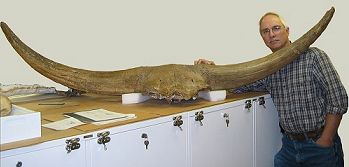
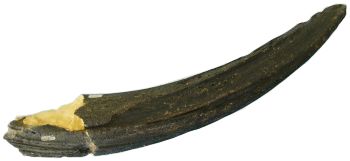
What distinguishes Bison latifrons is its size and tremendous horn span. Bison migrated to North America about 50,000 years ago. Today's species, Bison bison, evolved from a slightly larger species called Bison antiquus about 10,000 years ago. By then, Bison latifrons was already extinct.
Geological Ages of Rock Formations
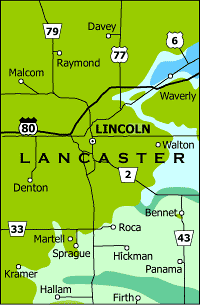
| Q | Pleistocene ("Ice Age") Sands, gravels, silts overlay much of the county (not shown) Pleistocene sands, gravels and silts overlay much of Nebraska and often conceal the bedrock beneath. These "Ice Age" deposits often produce the remains of mammoths, bison, horses, musk oxen, elk and other familiar mammals. Small fossils, especially, are important indicators of the climate at the time of deposition. |
| Kd | Cretaceous, Dakota Formation, 95-97 million years old The Lower Cretaceous Dakota Formation is exposed in several localities in eastern Nebraska especially along river courses that cut through younger sediments. These yellow, "rusty" sandstones mark the position of the edge of the Cretaceous mid-continental sea at the time of deposition. Few vertebrate fossils have been found in the Dakota Formation, but fossil leaves are common. |
| Pcg | Permian, Council Grove Group, 270-280 million years old Paleozoic rocks, mostly Pennsylvanian and Permian shales and limestones, are exposed in the eastern third of Nebraska, particularly in the southeast. These are mostly marine rocks and contain few vertebrate fossils. Occasional primitive shark teeth or bony fish skeletons are found in the shale units, but these are rare. Those interested in these early vertebrates or in the abundant invertebrate fossils found in these formations should consult the web pages of the Conservation and Survey Division for additional information. |
| Pa | Permian, Admire Group, 300-302 million years old |
| Pw | Pennsylvanian, Wabaunsee Group, 290-298 million years old |
| Ps | Pennsylvanian, Shawnee Group, 290-298 million years old |





